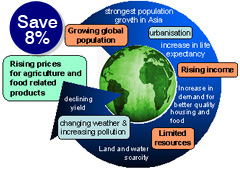
With an ever increasing demand for food and timber products, could now be the time to consider Agribusiness as an alternative to equities?
Over the last sixty years, the world has seen a significant rise in demand for food and building products. An ever increasing global population, due to lower mortality, increases in medical science and better sanitation, coupled with an increase in income, means that the demand for agriculture and food related products has risen significantly. Throw in global warming, a shortage of land and water, the recent industrialisation of the BRIC economies and the tax incentives offered by the Australian government, it’s not difficult to see why investment in agriculture is an investment sector not to be ignored.
With the end of the tax year fast approaching and the tax incentives offered to invest in this rapidly growing sector we felt that now is the ideal time for investors to consider adding what is commonly referred to as ‘Agribusiness’ to their portfolio. Our article this month highlights some of the things to look out for as well as some of the traps associated with Agribusiness investments
So what is Agribusiness and what are the benefits?
In a nutshell, agribusiness relates to agriculture related investments such as wood and food. There are currently large tax incentives offered for investment in this sector. Coupled with the recent increase in stockmarket volatility, many investors are looking to agribusiness as a way of diversifying their portfolio.
Tax incentives – Around 2001, the ATO recognised the potential shortfall in Australian agricultural production and introduced tax incentives for investors as a way of boosting local Agribusiness.
Diversification – Agribusiness returns show little correlation with the stockmarket and as a result are a good way of spreading the risk of your overall portfolio.
Product prices are expected to continue to rise – Global demand for land to build on, a surge in the global population and the use of ethanol from plant materials as an energy source are all increasing our demand and the resulting prices of agribusiness related products.
What to look for when investing in Agribusiness –
There are a wide range of investment opportunities being marketed, from Almond and Olive growing to some of the more established wood and timber product schemes. It’s easy to get confused when comparing one product with another. Our guide has been designed to simplify it for you.
Compare apples with apples – When you’re looking at some of the agribusiness investment opportunities it’s easy to get carried away with the anticipated returns on some of these funds. Bear in mind that some products such as almonds are not as established as forestry investments and as a result carry a higher investment risk, ie the projections used are just that and there may not necessarily be a track record to rely on. That’s not to say that a new tree or plantation won’t produce the anticipated returns, just that there’s a higher inherent risk and it’s unfair to compare these returns with those of established more stable agribusiness sub-sectors such as the wood chip offers.
The track record of the investment manager – Consider this, with many agribusiness products, you’re effectively locked in for a period of 12-25 years. Who do you want managing your money, a long term established provider that has had time to learn from their mistakes or a new company with little or no track record and a small balance sheet to back up their operations?

Comment: